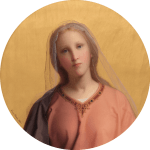Carl Müller (1818-1893)
Carl Müller was born in Darmstadt on 29 October 1818, the son of the court painter and gallery director Franz Hubert Müller (1784–1835). After his initial training with his father, he attended the Düsseldorf Academy where he would be appointed professor in 1857. Most formative were his visits to Italy to study quattrocento fresco painting. From 1840 on, Müller lived in Rome, favorite city of German painters in the nineteenth century. Müller’s specialty was portraiture and church decorations. His contribution to the frescos of the Franciscan church of Saint Apollinaris in Remagen, one of the most important examples of Neo-Gothic architecture in Germany, ensured that he became the most sought-after Nazarene artist of the Düsseldorf school. Müller’s serene Madonna set against a gold ground epitomizes the purity of faith Müller admired in his Italian predecessors.
The early presence of works by Müller in the United States may be credited to William Schaus (1821-1892), a German-born art dealer who began his career at Goupil & Cie in Paris, the leading gallery at the time. In the mid-1850s, Schaus was sent to Goupil’s American branch in New York, and it may have been his personal connection to Müller that prompted the arrival of the artist’s work across the ocean. In Müller’s biography, most likely it is Schaus who is: “An art dealer, who at that time was working as an agent in an American art gallery, told me with commercial enthusiasm how whole piles of photographs of Carl Müller’s painting of the Holy Family had been sent out day after day to the far reaches of the Union.” A large drawing of the Holy Family, bequeathed by Schaus to the Metropolitan Museum, attests to his involvement in promoting his fellow countryman.
The earliest collector of The Veiled Virgin was Reuben R. Springer, of Swedish origin and one of Cincinnati’s greatest benefactors. Another painting by Müller was bequeathed by Springer to the altar of the Blessed Virgin to his hometown’s St Mary’s Church, dedicated in 1842. Müller, often executing smaller versions of existing compositions for the American market, conceived the composition of the present Madonna originally for a prie-dieu for the Cologne Wrede family. The Veiled Virgin’s original American shadow box frame is most likely a marriage introduced by Goupil & Cie. for the local market as the presentation appealed to collectors of the Gilded Age. The elaborate shadowbox protected the gilding from oxidation and the velvet from attracting dust under the glazing, creating a time capsule for the entombed painting.
Provenance
Manuel A. de Lizardi y Cubas (1836-1916), New Orleans, 1873, consigned to
Goupil & Co., New York, two labels on the verso, sold to
Reuben Runyan Springer (1800-1884), Cincinnati, 1874
Private collection, New York
Literature
Heinrich Finke, Carl Müller. Sein Leben und künstlerisches Schaffen, Cologne 1896, p. 116



